
Small Slips, Big Lessons
Contents
- Editorial
- Share with CHIRP
- **FREE** GA Safety Workshops
- Subscribe to CHIRP FEEDBACK
- Good Ideas Shared
- 5% Discount at Pooleys
- Safety Special - Paragliding and Hang Gliding
- ILAHFFT - Static, Storms and Stuck Mics
- ATC869 - Inadvertent airspace infringement
- GA1391 - Taking care around aircraft
- GA1394 - Wing tank fuel starvation
- GA1395 - SkyDemon ‘Flyable Conditions’ feature reliability
- GA1393 - Magneto magic
- GA1392 (S&P) - Skydiving reserve ride after tension knots
- GA1397 - Where shall I park?
The Power of Sharing
CHIRP recently hosted the International Confidential Aviation Safety Systems Group annual conference in London. Among the many fascinating discussions between the 16 attending nations, a recurring theme was understanding the barriers to reporting and how to overcome them. Even in aviation organisations with well-established Safety Management Systems, there is still resistance to reporting. The reasons are familiar: fear of punitive action (a lack of just culture), a belief that nothing will change so there’s no point (learned helplessness), a lack of feedback, the pressures of a busy day, or simply that the reporting process “feels too difficult”.
How does this read across to General Aviation? For most of us, GA is flying for fun and after squeezing in a quick flight at the weekend, the thought of writing a report probably isn’t at the front of the mind. The very fact that you’re reading this edition of GA FEEDBACK means that you understand the benefits of reporting; but many in the wider GA community don’t. Perhaps those more familiar with the process can help spread the word. Some nations even incentivise reporting with prizes; would that work in the UK? For those who don’t work within an aviation organisation, the reporting options available might not even be clear. Hopefully this doesn’t apply to CHIRP, but for some private pilots and sport flyers, the idea of submitting a report to an ‘authority’ system – such as a Mandatory Occurrence Report, infringement or Airprox notification – can feel intimidating. So, what can we do as a community to demystify these options and build trust and confidence in the benefits of reporting?
Even the word ‘report’ itself can sound negative, implying judgement or embarrassment over mistakes. There’s no place for ego in aviation, yet there will always be a degree of reluctance to bare one’s soul and admit error. Perhaps the idea of ‘sharing’ would evoke a more positive sentiment. After all, in aviation, as in life, almost everything goes right and there’s just as much to learn from what works as from what doesn’t. Sharing doesn’t need to be formal (although we always welcome reports at CHIRP). Whether it’s over a cup of tea in the clubhouse, through the group WhatsApp chat, or on the drive home with a flying friend, talking about what went well – and what nearly didn’t – can be both cathartic and constructive. Your experience might just help someone else avoid a bad day.

This edition of GA FEEDBACK is full of examples of pilots doing the right things: stopping when unsure on the ground, continuing to fly the aircraft at all costs, making difficult airborne decisions such as cutting away a malfunctioning parachute, and sharing their experiences so that others can learn. It also reminds us that safety gains multiply when lessons are shared beyond our own cockpit.
We were also delighted to meet many of our readers in person at the LAA Rally at Leicestershire Aerodrome this summer. Events like this are a great opportunity to talk with fellow aviators, exchange stories and ask questions. Collaboration through community remains one of the most powerful ways to build a strong safety culture. Rather than tackle challenges alone, join associations and clubs, attend safety evenings, and take every opportunity to keep your knowledge current and your mindset sharp.
Finally, throughout this edition you’ll notice a common thread of how small slips, assumptions, or misjudgements can cascade into larger problems. The pilot who nudged a fence while distracted, the one who experienced a stuck microphone, or the skydiver facing a rapid malfunction all illustrate how subtle human factors shape outcomes. Value the ‘small stuff’ in reporting and in sharing, because that’s often where the most useful learning lies. Keep communicating, reflecting and challenging yourself.
Grab a coffee, put your feet up, and enjoy this edition of GA FEEDBACK. Then think about sharing your experiences with CHIRP – just read on to find out how easy it is.
Please be the difference; we’d love to hear from you.
Nicky Smith, Director Aviation
Share with CHIRP
Have you had an incident or a near miss? Could CHIRP help or offer advice on a safety concern? Perhaps you’ve experienced or observed something with a human factors angle that you think the wider aviation community could learn from. Why not share it with CHIRP?
Every report helps raise awareness of safety issues, highlights emerging trends and shares valuable lessons with others. Report by report, we can all contribute to making aviation safer – as our strapline says:
“You report it, we help sort it.”
Reporting to CHIRP is simple and quick using either our website portal or the CHIRP App (scan the relevant QR code or search for ‘CHIRP Aviation’, but watch out for the birdsong apps!). The portal presents a series of fields for you to complete, but not every field is mandatory – just tell us as much as you can. The more detail you provide, the more effectively we can help.
Although you’ll be asked for an email address to access the system (to screen out bots and spam), your personal information is held securely within CHIRP’s independent systems and is never shared outside the organisation. Importantly, nothing that could identify a reporter is included in any report we progress or publish. We liaise with you at every stage and no information is passed on without your express consent.
So rather than ‘fly and forget’, please consider working with CHIRP to help make the skies safer for everyone. However, it’s important to note that reporting to CHIRP is not a substitute for submitting a Mandatory Occurrence Report (MOR) when required, for example, when there has been a significant risk to safety, or an event that could have endangered the aircraft, its occupants, or others. MORs should be submitted via the CAA’s ECCAIRS 2 portal.

**FREE** GA Safety Workshops
Have you checked out the Astral Aviation Consulting free General Aviation Safety Workshops yet? These online events are designed for GA pilots and consist of discussions with GA experts aimed at improving your flying knowledge and skills. The next event is Masterclass No3: ‘Global Navigation Satellite Systems’, which takes place on Wednesday 26th November at 7.30pm. This will be a 75-minute look into all things GNSS, how best to use it, pitfalls and what to do if you encounter jamming or loss of signal. Previous workshops on subjects ranging from partial power loss to human factors, winter weather to effective Check As plus the link for the next workshop can all be found at https://www.astralaviationconsulting.com/safety-workshops.

Subscribe to CHIRP FEEDBACK
The fact that you’re reading this means you already know about CHIRP General Aviation FEEDBACK? In case you don’t receive our emails with links to new editions, as well as our sister Air Transport, Drone/UAS and Cabin Crew versions, please use the subscribe option, which can be found at the bottom of our website https://chirp.co.uk/aviation/subscribe/. Through this link you will soon have the option to request paper copies of GA FEEDBACK too. Alternatively, email us at mail@chirp.co.uk with your name, address and number of copies required, and we’ll add you to our mailing list.

Good Ideas Shared
CHIRP would like to thank the British Microlight Aircraft Association (BMAA) for very kindly including a CHIRP promotional flyer in all 3,350 copies of their recent publication mailed to members. Collaborative efforts like this help strengthen our shared goal of improving safety across General Aviation. Are there other GA organisations who might work with us in a similar way to encourage reporting and support the safety message? If so, we’d love to hear from you – please contact the Aviation Team at mail@chirp.co.uk.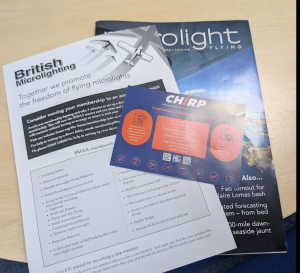
While we’re talking about good ideas, CHIRP also noted the BMAA Wings Award Scheme, which encourages members to enhance their flight planning, handling skills and overall understanding of aviation safety, all aimed at helping pilots become safer and more proficient. A great initiative and an excellent example of positive safety culture in action.
5% Discount at Pooleys
Pooleys have kindly agreed to support CHIRP’s fund-raising activities by allocating us a discount code on their website shop. Enter the code ‘Chirp’ (case sensitive) at the appropriate point at the payment stage to get 5% discount and generate some commission for CHIRP. Sadly, this doesn’t apply to the purchase of Bose headsets, but everything else qualifies. If you do use Pooleys (https://www.pooleys.com) for your purchases, or know other people who do, please do share the code. The more the code is circulated, the more it is used and the greater the commission generated to help CHIRP build its resources to do more.

Safety Special - Paragliding and Hang Gliding

A recent discussion around a CHIRP report highlighted an interesting aspect of the UK’s aviation landscape: we enjoy one of the most permissive air environments in the world. Many forms of aviation – including paragliding, hang gliding, paramotoring, gliding and other non-Part 21 aircraft – operate outside direct CAA regulation. These activities generally carry first- and second-party risk, with minimal third-party exposure.
While the absence of regulation provides freedom, it does not remove the requirement to comply with air law and the Air Navigation Order. In theory, anyone could purchase equipment and fly without training, experience, insurance, or membership of a recognised support organisation, though few would regard this as either safe or sensible.
For paragliding and hang gliding, the recognised body is the British Hang Gliding and Paragliding Association (BHPA). The BHPA oversees pilot and instructor training standards, provides technical guidance and maintains airworthiness oversight. It also supports a nationwide network of recreational clubs and registered schools, where new pilots can receive structured professional instruction. The BHPA website (www.bhpa.co.uk) hosts a wealth of valuable safety information, including all issues of Skywings magazine, which contains regular and insightful safety content.
BHPA membership is strongly recommended for anyone involved in these flying activities. Beyond the wealth of safety and technical support available, membership provides automatic £5 million third-party insurance which is available only to those trained to BHPA standards. The Association also requires higher standards and additional qualifications for tandem pilots, reflecting the greater responsibility and increased risk of flying with passengers.
CHIRP would actively encourage anyone interested to give paragliding or hang gliding a try. Once you have your equipment, have received appropriate training and joined a local club, it remains one of the most affordable and exhilarating ways to fly. But as always, safety and responsibility should come first.
Points to consider before taking to the air:
- The safety and insurance benefits of BHPA membership are significant – please join before you fly.
- Operating in UK airspace without understanding the Air Navigation Order is both unsafe and irresponsible.
- CAP2562, the Paramotor Code offers valuable guidance relevant to similar forms of flight.
- Pilots carrying passengers in the unregulated sector have a duty to gain training specific to this higher-risk activity.
- Passengers paying for tandem flights are advised to ensure that their pilot holds BHPA membership and appropriate insurance.
As ever, good preparation and sound judgement are the best enablers of enjoyment – fly safely and savour every moment aloft.
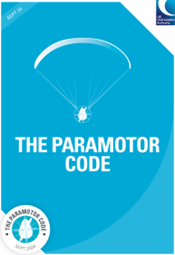
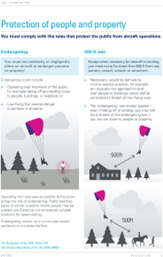
I Learnt About Human Factors From That
Static, Storms and Stuck Mics
A CHIRP GA FEEDBACK reader shared this tale of how a calm, sunny post-storm day turned into a practical masterclass in patience, preparation and problem-solving. It’s a great example of how even simple flights can test our systems knowledge and human resilience in equal measure.
I flew to Jersey recently, just before a named storm hit. Despite tying the C-172 down firmly facing the wind and using all 3 anchor points, it weathercocked 30º overnight but held. When the weather cleared, I headed back to the mainland; the weather CAVOK, full sun and a gentle breeze. The aircraft was wet when I carried out a careful Check A and I was particularly careful to ensure that no water had entered the fuel. I called for taxi clearance, but the radio was unusually crackly – I assumed this was due to a known dead spot behind the bowser.
On taxying to the hold, I was aware of considerable interference on air. The tower was only partially audible and I was being asked to repeat messages, as I requested the tower to do likewise. I then heard the words “stuck mic”. After a couple of failed radio checks, this was also displayed on my set, so I changed headsets to no avail, and I switched the radio off. Using a handheld radio at the holding point, I requested clearance to taxi back for further investigation.
The excellent engineering facility was very helpful and spent 90 minutes dismantling and re-tightening the wiring as well as checking both headsets. Clear communications were restored. I then attempted a re-start, only to find that the battery was dead due to the time that it had been discharging on the ground. Again, I was helped with a jump start and the flight continued successfully, with no further incident.
This experience highlighted several learning points:
- Always tie down properly, especially when there is any danger of high winds.
- Fully confirm all ATC communications in both directions.
- Have a spare headset plugged in and ready – loudspeakers and hand mics are a last resort and not appropriate for long flights.
- Have a handheld radio ready, tuned and fully charged.
- Consider a low wattage mains cockpit heater if aircraft are left in damp conditions.
- Minimise power use when not charging. NB beacon lights can draw 10amps. Fully lowering flaps pre-flight is also very power-hungry.
- Be humble enough to accept help and not press on, unless 100% certain that the basics are in order.
Final thoughts:
- Not all flying is fair-weather. It’s a privilege and not a right. Be prepared and then prepare again.
- Engineering facilities in Jersey are top notch and also free of VAT – highly recommended!

Reports
ATC869 - Inadvertent airspace infringement
Initial Report
The incident resulted in an inadvertent infringement of [Airfield B Zone] as a result of pilot misunderstanding of [Airfield A and Airfield B] relationship. I was the pilot of a microlight on a lengthy planned UK flight. Due to limited clearance between cloud base and the terrain and reduced visibility the aircraft diverted from the planned course into lower ground rather than push on into rising terrain or divert [in opposite direction] where the terrain was even higher. I am not local to the area and had not flown there previously. The diversion route had to be quickly worked out and followed and reliance was made on the SkyDemon moving map and using the local knowledge of the controllers to assist.
I asked for and received a basic service from [Airfield A] LARS since I would be crossing their area and was wearing a transponder code allocated by the controller. I was additionally monitoring [Airfield B frequency] as I routed towards [Airfield B Zone]. My aircraft entered [Airfield B Zone] with a service from [Airfield A] and stayed with [Airfield A] who passed information whilst I was transiting [Airfield B Zone]. I left [Airfield B Zone] and requested a change to [Airfield C]. [Airfield A] controller did not pass the aircraft over to [Airfield B] at any stage nor suggest a frequency change and continued to provide a basic service. No relevant transmissions from [Airfield B] were heard on the monitored frequency. I remained outside [Airfield B] ATZ throughout.
I assumed that the [Airfield A] controller did not hand me over to [Airfield B] because it wasn’t needed due an operational agreement between [the two]. I remembered mention of operations [between the two airfields with a specific agreement] in an earlier preflight brief. SkyDemon flashed a brief warning regarding [Airfield B Zone] just as the aircraft entered it.
I remember there was a second aircraft with a similar call sign on [Airfield A] frequency and then [Airfield C] frequency at the time. The pilot of G-XXXX requested clarification from [Airfield A] due to confusing call signs and messages relating to service. Shortly after [Airfield C] controller explicitly requested full call signs and this request was acknowledged by the pilot of G-XXXX. It may be that that the confusion due to similar call signs led to the [Airfield A] controller not handing me off.
I had no reason to suspect anything was wrong until the CAA infringement team sent out a letter requesting information relating to an alleged infringement inside [Airfield B Zone] by [my aircraft] wearing a code that was not from [Airfield B].
After receiving the CAA letter, I contacted ATC [at Airfields A and B] and explained what had happened and apologised to [Airfield B]. It transpires that the operational agreement I recollected whilst airborne did not include non-[Airfield A-based] aircraft. [Airfield B] are happy to offer a ‘LARS like’ service for the [Airfield A operating area] because their radar coverage overlaps. [Airfield B] radar service and coverage is not shown on CAA or NATS literature, but they are essentially a LARS. [Airfield B] was not busy and the controller explained that they knew the aircraft was likely on [Airfield A] frequency but didn’t blind call me on [frequency] or phone [Airfield A], before the aircraft had changed to [Airfield C]. [Airfield B] did not have the ability to see Mode S and call signs natively and later identified the aircraft using an online ADSB service to file a MOR.
Lessons Learned: I made the mistake of assuming that the [Airfield A] controller would hand me off to [Airfield B] if it was necessary and if they didn’t then it wasn’t necessary due to [a local operational agreement]. Unfortunately, basic service can be really basic.
CHIRP Comment
A microlight pilot inadvertently infringed controlled airspace, discovering the breach only afterwards. They subsequently reported the event to CHIRP and thoughtfully analysed the contributing factors for wider learning. CHIRP is grateful to the reporter for their openness and for sharing the safety lessons that arise. The incident was also reviewed by the CAA’s Infringement Coordination Group (ICG); CHIRP’s reflections here focus only on the human factors evident from the report.
There appear to have been several mitigating and compounding elements that contributed to the pilot’s misunderstanding and procedural error during a weather-related diversion. The reporter’s observation that “a basic service is very basic” is a fair reminder that many GA pilots still misunderstand the limitations of Air Traffic Services (ATS) outside controlled airspace. We’ve provided a brief refresher of the main UK Flight Information Services at the end of this article; more detail can be found in CAP774: UK Flight Information Services and CAA Safety Sense Leaflet 22: Radiotelephony.
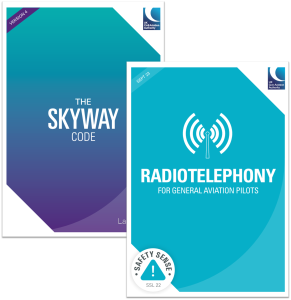
When operating outside controlled airspace, particularly during diversions or under high workload, pilots are encouraged to request a Traffic Service (TS) where available. As well as supporting your geographic spatial awareness, a TS also helps mitigate the risk of mid-air collision. If a TS is declined, it is entirely acceptable to explain the circumstances and ask ATC for assistance. Although the controllers’ actions were technically correct in this case, there might have been scope for a more proactive handover or supportive coordination, given the pilot’s weather diversion and unfamiliarity with the area. Aviation is, after all, a team activity.
A key lesson that emerges is: “never assume, always check.” GA pilots sometimes hesitate to make non-standard R/T calls, but if unsure, it is always better to ask rather than assume. Perfect phraseology is far less important than maintaining situational awareness. On longer flights, especially in unfamiliar airspace, effective pre-flight planning and robust Threat & Error Management (TEM) reduce the likelihood of an infringement and preserve capacity when things change in flight. More comprehensive TEM might also have prevented the confirmation bias that led the pilot to discount the SkyDemon alert. Instructors may wish to use this example when training for in-flight replanning and diversion exercises, incorporating FREDA checks and R/T practice into the process.
In this case, the infringement came to light only when the CAA’s ICG contacted the pilot following the submission of a Mandatory Occurrence Report (MOR) by ATC. The pilot’s subsequent engagement with ATC and CHIRP were commendably open. MORs are not punitive; they exist to promote systemic learning. The CAA’s CAP1404: Airspace Infringements process ensures that each case is reviewed fairly and proportionately by the ICG. Notably, no pilot in the UK has ever lost their licence solely as a result of an infringement, yet lingering myths continue to discourage some from engaging with the process. Over half of all cases are closed with advisory letters; only repeat or serious occurrences typically require additional training, such as the Infringement Awareness Course, which in itself is an excellent learning opportunity. Pilots who suspect they may have infringed are encouraged to contact the ICG proactively and explain the circumstances. Of note, the ICG review of this inadvertent infringement included an educational letter to the pilot pertaining to possible safety improvements in things like pre-flight planning.
Finally, CHIRP has reflected on the broader issue of trust between GA pilots and regulatory bodies such as the CAA, UKAB and AAIB. Some pilots still perceive these organisations as punitive rather than supportive. Just as we encourage pilots to engage openly with the system, safety bodies must reciprocate by communicating clearly, constructively and respectfully. CHIRP understands that the tone of some earlier CAA correspondence was perceived as unfriendly but welcomes the recent shift towards a more inclusive and helpful style, which appears to have improved pilot engagement with CAP1404 overall. We encourage readers to continue sharing their experiences – positive or negative – so that this feedback can further strengthen safety culture and understanding.
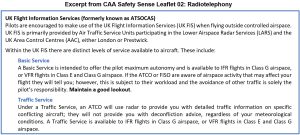
As an aside, have you ever decided not to request a Traffic Service because you thought there was no point and it would just be refused? The problem with this kind of ‘learned helplessness’ is that it leaves no record of the issue. Much better to ask. You’ll either receive the service – result – or be denied, often due to controller workload. In that case, you can helpfully share the experience with the CAA using the UK Airspace Access or Refusal of ATS Report Form (FCS1522). Submitting this form helps the CAA collect data on refusals and supports work towards improved airspace access and safer services for all.
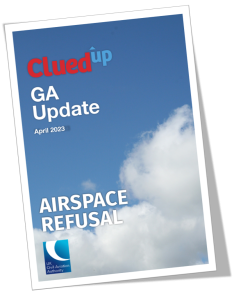
Key Issues relating to this report
Human Factors Considerations
The following ‘Dirty Dozen’ and Human Factors were a key part of the CHIRP discussions about this report.
Positive factors:
- Safety mindset – open reporting and willingness to share lessons for collective learning.
- Situational awareness recovery – effective use of post-event reflection to identify gaps in planning and communication.
- Communication/Learning – recognition of personal error and engagement with ATC to better understand events and prevent reoccurrence.
- Adaptability – safe decision to divert rather than continue into deteriorating weather or rising terrain.
Negative influences:
- Skill/Decision Error – assumption that an ATC handover would occur automatically under a Basic Service.
- Situational awareness – incomplete understanding of local airspace relationships and service responsibilities.
- Confirmation bias – disregarding the SkyDemon alert owing to an expectation of controller coordination.
- Coordination/Communication – lack of clarification between ATC units and pilot about service expectations.
- Time pressure and workload – cognitive overload from weather, terrain, unfamiliar airspace and R/T distractions contributing to reduced monitoring.
- Complacency / procedural drift – reliance on assumed operational agreements rather than confirmation.
GA1391 - Taking care around aircraft
Initial Report
During pre-flight inspection I accidentally walked into a flap that was in the down position receiving a serious cut to the top of my head. I had to have 9 staples to close the wound.
Aircraft can be dangerous with many sharp edges. Be extra careful during pre-flight checks. During my career in aviation (25 years) I have seen many injuries received by others during pre-flight inspections, but fortunately I have escaped injury until now.


Lessons Learned: The main human factors that I identified from this incident were a lapse in concentration, not being 100% diligent on my pre-flight inspection and not remembering the hazards that are present whilst being around aircraft. Other factors could also be involved in similar incidents such as time pressures, distractions etc.
As a flight instructor I am using my new scar and experience in pre-flight Threat & Error Management (TEM) briefings with students and other pilots to highlight the threats that are present whilst being airside around aircraft and how to mitigate and avoid the dangers.
All images reproduced by kind consent of reporter
CHIRP Comment
This was an open and honest report describing an event that could happen to anyone, and probably has to many of us, albeit not always with such a dramatic outcome. The reporter’s reflections contain valuable human factors insights about operating around aircraft, particularly during pre-flight checks. Their willingness to share this painful lesson will no doubt help others avoid similar mishaps.
Beyond the obvious message – “try not to bump into things” – there are several wider safety considerations. Far more injuries occur on the ground than in the air, yet these are often under-reported. Although technically an injury does not become a ‘reportable incident’ until the pilot enters the aircraft with the intention of flight, such occurrences should still be reported so that common themes can be identified and safety improvements made.
Working around aircraft exteriors can be surprisingly hazardous. Walk-rounds should never be rushed; it is far better to find a defect or problem on the ground than in the air. Student pilots should be briefed about external hazards during initial and differences training, and pilots should remain alert to the particular features of their own aircraft. When carrying passengers, a short, calm briefing about key external hazards can help prevent accidents, as noted in Safety Sense Leaflet 2 – Care of Passengers in GA, which was highlighted in CHIRP GA FEEDBACK Edition 105. Pilots have a duty of care for their passengers and should always accompany them on dispersal; inadequate briefing might even have implications for insurance liability in the event of injury.
Typical hazards include flaps, aerials, pitot tubes and tailplanes that can be walked into; fluids that can splash into eyes; or steps on low-wing aircraft that can cause falls. Many professionals working airside wear bump caps, which can be purchased relatively cheaply (£15-£20) and may be worth considering for GA use. Similar arguments could apply to other forms of personal protective equipment when appropriate.
It’s not just people who can get hurt – any impact can also damage the aircraft, particularly older ones where skin or structure may already be fragile. Care, time and situational awareness during pre-flight inspection are essential defences in preventing both personal and aircraft injury. Finally, don’t forget that if you’re distracted during your pre-flight for any reason, it’s good practice to go back to the beginning or a known break point and start again, rather than try to carry on from where you stopped.
Key Issues relating to this report
Human Factors Considerations
The following ‘Dirty Dozen’ and other Human Factors were a key part of the CHIRP discussions about this report and are intended to provide food for thought when considering aspects that might be pertinent in similar circumstances.
Positive factors:
- Safety mindset – constructive reflection and learning attitude following the event.
- Communication and knowledge sharing – willingness to use personal experience to promote safety awareness among others.
- Training application – effective use of the incident as a teaching point within TEM briefings.
- Self-awareness – recognition of contributory factors such as lapse, distraction and time pressure.
- Defensive behaviours – proactive reinforcement of safe habits around aircraft.
Negative factors / latent conditions:
- Lapse in concentration – temporary reduction in attention leading to contact with the aircraft.
- Complacency/Attention – familiarity with routine tasks reducing perceived risk.
- Time pressure/Distraction – external or self-imposed pressures affecting focus during pre-flight.
- Hazard awareness – limited consideration of physical risks around aircraft exteriors.
- Personal protection – absence of protective headwear increasing injury risk.
GA1394 - Wing tank fuel starvation
Initial Report
Report Text (precis): During a short general aviation flight in a light single-engine aircraft, two qualified pilots were on board – one acting as pilot in command and the other flying as a passenger. The fuel state prior to departure was known to be low in both tanks, and although topping up was considered, the decision was made to proceed with the flight using the available fuel.
The outbound leg was flown without incident. However, on the return leg, having flown entirely on one fuel tank, the engine suffered a sudden failure while descending overhead the destination airfield. The pilot in command immediately switched to the opposite fuel tank and the engine restarted. The aircraft was then landed calmly and safely.
After shutdown, a visual inspection revealed that the tank in use at the time of the flame-out was empty. The situation was later reported to the flying club by the pilot in command.
CHIRP Comment
This incident provides a powerful reminder of several key GA safety principles, particularly around fuel management and cockpit communication. It is a positive step that the event was reported to the CFI and that the P1 remained calm and acted swiftly to recover the situation. However, the situation could easily have ended very differently.
The key lessons include:
- Never rely on minimum fuel for a flight, no matter how short – build in a margin and err on the side of caution. Fuel in the aircraft is always better than left in the bowser.
- Cross-checks are essential – especially when flying with another qualified pilot, there is value in mutual oversight and the sharing of observations.
- Threat and Error Management (TEM) principles should be applied to every flight, however routine – particularly in planning stages, where risks like low fuel can be identified and mitigated.
- FREDA checks are there for a reason. Rigorous in-flight checks provide multiple opportunities to spot and correct developing threats before they escalate into emergencies.
- Crew Resource Management (CRM) and authority gradient considerations are not exclusive to the commercial cockpit. It can be difficult to speak up assertively as a passenger, but it can be even harder for a PIC to receive advice, especially if ego or familiarity plays a role. Respectful two-way communication and a willingness to listen are vital. Breaking down a hierarchy in the cockpit and stressing that none of us are infallible can assist a voice to be heard. To assist a passenger or crew in escalating concerns, the graded assertiveness method – Probe, Alert, Challenge, Emergency (PACE) – is a useful guide. Another suggestion if you’re feeling uncomfortable is Ask, Suggest, Insist (ASI). This enables a discussion rather than an argument and highlights the outcome or consequence of not taking a suggested action, eg in this case the outcome of not taking sufficient fuel could be “we will run out of fuel”.
The reporter in this case did the right thing in voicing concerns and remained observant throughout, as all passengers with relevant knowledge should. A shared culture of openness and mutual support in the cockpit, regardless of role, is critical to safe flying.
CHIRP encourages pilots to see such near misses not as failures, but as invaluable learning opportunities that, when shared, can make a real difference across the wider community.
Finally, although not necessarily relevant in this case, CHIRP notes that some syndicates have informal rules about landing with minimal fuel remaining to allow flexibility for the next pilot. Such practices can create undue pressure to operate with marginal fuel reserves. This is not considered good practice; pilots are encouraged to prioritise safety and maintain an appropriate margin for error over adherence to syndicate conventions.
Key Issues relating to this report
Human Factors Considerations
The following ‘Dirty Dozen’ and Human Factors were a key part of the CHIRP discussions about this report.
Positive Considerations:
- Prompt decision-making – the PIC responded quickly to the engine failure and restored power effectively.
- Calm under pressure – both pilots managed the situation without panic and ensured a safe landing.
- Post-flight transparency – reporting the incident to the club enabled learning and reflection.
- Vigilant monitoring – the passenger remained observant and engaged, contributing to situational awareness.
Areas to consider:
- Decision-making – choosing to depart with low fuel introduced avoidable risk.
- Planning & preparation – insufficient fuel reserves suggest inadequate pre-flight planning.
- Authority gradient – potential reluctance by the passenger to challenge the PIC’s decision.
- Communication – a clearer, shared discussion about the fuel state may have prompted a different choice.
GA1395 - SkyDemon ‘Flyable Conditions’ feature reliability
Initial Report
Report summary: A GA pilot raised concerns about the reliability of the “Flyable Conditions” feature within SkyDemon. On two recent occasions, the “Flyable Conditions” overlay differed significantly from actual weather observations, both visually and as reported in METARs. On the latter occasion, the SkyDemon support team acknowledged an error in the feed from the forecast provider and advised that a fix had been applied. However, no subsequent explanation was provided as to what safeguards or quality assurance measures are in place to identify such issues proactively or prevent recurrence. The reporter is concerned that, without such measures, incorrect or misleading information may continue to be presented to users without clear caveats.
In particular, the reporter queried whether it would be more appropriate either to:
- Include a more explicit disclaimer regarding the limitations of the “Flyable Conditions” data, particularly in terms of accuracy and validation; or
- Remove the feature altogether if its reliability cannot be assured.
CHIRP Action
CHIRP approached SkyDemon on the reporter’s behalf and asked the following questions:
- How is forecast data for “Flyable Conditions” sourced and processed, and what checks (if any) are applied before it is displayed in the App?
- How are errors identified and addressed, and is there a means of alerting users when data is known or suspected to be inaccurate?
Are there plans to improve the reliability or presentation of this feature, or to consider including stronger caveats about its limitations?
SkyDemon Comment
We have reviewed the notice displayed to pilots when they first use our Flyable Conditions feature (attached the English version) along with relevant pages in the user guide it alludes to (41, 42, 43).
Notice reads:
“This layer is a forecast showing ceiling and visibility over a wide area. It is coloured according to your own preferences for visual conditions. It does not include rain, storms or other significant weather.
For more information on how to use this layer to help you decide where to fly, including safety best practices, consult the user guide.
Hold a finger on the information at the bottom of the map to change your preferences.”
We’re satisfied that we make clear that the feature in question is a forecast and go into some detail on how it works and how to set it up to deliver the personalised graphics it’s designed to produce. We also explain why it may differ from METARs from time to time. Most of our users have gone through PPL training, and for that reason we don’t think it is necessary to explain what a forecast is, or labour the point that a forecast can (and often will) differ from the actual conditions that transpire to some degree.
We did have an issue with the feature in April. It turned out that a mistake by our suppliers resulted in incorrect data being delivered to us. Once we became aware of the problem, we quickly determined the nature of it and reported it to them for a swift fix. Importantly, the system failed safe by design: it erroneously told users that some areas were not flyable, when in fact they were. We do of course have the ability to stop the supply of the data if that should ever become necessary. We had detailed follow-up discussions with our supplier, as you would expect, to establish exactly what went wrong and how, and have satisfied ourselves that they have put measures in place to minimise the chance of it ever occurring again.

CHIRP Comment
Credit to SkyDemon for this comprehensive explanation and for designing the system to ‘fail safe’. This report usefully highlights the potential safety risk of over-reliance on electronic planning and flight aids without adequate cross-checking. SkyDemon has become an indispensable tool for many GA pilots, but like all software it’s only as reliable as its data inputs and the user’s understanding of its limitations. In this case, the anomaly was spotted because the reporter cross-checked multiple sources, something that not every pilot may do.
Instructors increasingly report pilots arriving for club check-outs or lessons having based their planning solely on “what SkyDemon says”. While the software is an excellent aid to situational awareness and can help mitigate risks such as airspace infringements, it is not a substitute for independent weather assessment and sound pre-flight preparation. Features such as “Flyable Conditions” can be helpful visual indicators, but they are still forecasts, subject to the same uncertainties as any meteorological product. On marginal weather days especially, a display that suggests “flyable” could unconsciously bias a pilot’s decision-making towards launching when conditions merit more caution.
Good airmanship means using technology as a tool, not a decision-maker. Pilots should continue to interpret TAFs, METARs and other weather data themselves, comparing outputs from different sources and checking how well automated features align with actual conditions. That human layer of sense-checking and scepticism is what keeps electronic assistance working for us rather than in place of us.
Key Issues relating to this report
Human Factors Considerations
The following Human Factors were central to CHIRP’s discussions on this report:
- Complacency – trusting an automated system without sufficient verification.
- Situational Awareness – maintaining a full picture of weather and operational risk using multiple data sources.
- Decision-making – resisting confirmation bias when an app’s output aligns with a desired outcome.
- Knowledge & Skill – maintaining proficiency in interpreting meteorological data independently.
- Communication – encouraging instructors and peers to discuss and challenge over-reliance on automation.
- Safety Mindset – applying critical thinking and continual cross-checking to validate electronic information.
GA1393 - Magneto magic
Initial Report
I fly a lot of different types, including a DHC-1 Chipmunk. While it is a real privilege to be able to fly this aeroplane and even aerobat it, its ergonomics set-up is, of course, “of its time” and has many weak points, vastly improved in later machines. One of these is the placement of the magneto switches. In the front cockpit of the aeroplane I fly, they are in the lower left-hand corner of the panel.
Because I jump between types quite a lot, I have developed a very rigorous approach to checklists. And before each flight, I give myself a very detailed briefing of what is where in each particular airframe.
On this particular day, my plan for the Chipmunk was to do a few circuits and some general handling, building up to gentle aerobatics. The aeroplane had been unserviceable for a while, so I wanted to get back into the groove. As usual for me before a first flight on type after a lay-off, I did all the checks three times, first by “flow”, then by following the checklist, and then, finally, by following a somewhat silly mnemonic I use before take-off. The first circuit was uneventful, I landed and taxied off (I never do a touch-and-go in tailwheel aircraft), ran the checks and took off again.

On downwind, I did my usual checks; everything was fine. This was to be a glide approach, so I took the power off and turned a very close base. The aeroplane immediately started vibrating. I focused on flying the aeroplane and landed uneventfully. As I turned off the runway, I looked around the cockpit and noticed that one of the magneto switches was in the down and off position.
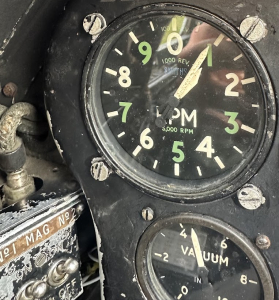
I could only surmise that I switched it off by accident, without noticing. I have only one theory as to how this may have happened. In the Chipmunk, I use an RAF-surplus flying suit. Its sleeves are a bit wider than they should be, and it might just be possible that I caught the switch with the opening of my left sleeve. It’s either this or the even scarier thought I had deliberately put the switch into the OFF position for some reason, but my brain had failed to register it. If the former theory is true, the situation would have been very dangerous – what if I’d caught two switches, not one? If the latter is correct, then I should, perhaps, see a doctor. I am only joking, of course, but you can’t rule anything out!
Lessons learned: I now use a rubber band around my suit sleeves, to keep them even tighter around my arms.
CHIRP Comment
As any GA pilot will attest, discovering a magneto switch selected to OFF in flight would be an unnerving experience, particularly when the cause is uncertain. Whether the switch was accidentally caught by a flying-suit sleeve or mis-selected through a momentary cognitive lapse, this report is an excellent example of a “third age” report: one that nobody else could have known about unless altruistically shared. The reporter deserves full credit for their honesty and humour in describing a situation that offers valuable human factors lessons.
Two possible causes were identified. The first – that the sleeve of the flying suit caught and moved the switch – is entirely plausible. Loose clothing can easily interfere with cockpit switches, with potentially serious consequences. It’s a timely reminder to select appropriate clothing for the task. In addition to avoiding garments that might snag or obscure controls, pilots should consider clothing suitable for other risks too. For instance, fire-resistant materials for balloon operations or warm layers for cold-weather flying (especially in the event of a possible forced landing). Long hair or jewellery can also catch on switches, or move controls, or become trapped in a canopy causing injury; passengers should likewise be briefed on suitable clothing for comfort and safety. Threat & Error Management (TEM) isn’t just about the flight plan; it extends to preparation, equipment and environment.
The second possibility is that the magneto switch was mis-selected, either during the pre-flight checks or in flight, and simply not noticed. Despite diligent checking, it’s easy for expectation bias to creep in, leading us to ‘see’ what we expect rather than what is actually set. Checklists are a vital defence against error, but no system is foolproof. For multi-crew operations, challenge-and-response checking provides an extra safety layer; for single pilots, ‘read and point’ is a recognised technique to reduce error probability. Ultimately, action errors – where the correct intention is formed but the wrong action is taken – can never be completely eradicated, but their exposure can be reduced through disciplined routines and continuous awareness. Of note, in 1970 the Chipmunk rear cockpit magneto switches were modified to include a guard, which prevented inadvertent deselection by curious passengers; the front cockpit though wasn’t similarly modified!
In this case, the pilot approached the flight responsibly: aware of not being current on type, mindful of differences between aircraft, and methodical in preparation. Yet, as often happens, human variability still found a way through the defences. Faced with unexpected vibration, the pilot did exactly the right thing i.e. stayed calm, flew the aircraft and landed safely. Perhaps there was more cognitive load at play than realised, with a combination of recency, aircraft differences and tailwheel handling considerations subtly raising workload. Whatever the root cause, it’s likely that magneto switches will now feature more prominently in this reporter’s scan, and that the sharing of this experience will help others stay alert to similar traps.
Key Issues relating to this report
Human Factors Considerations
The following ‘Dirty Dozen’ and Human Factors were a key part of the CHIRP discussions about this report.
Positive HF elements:
- Safety/learning culture – proactive self-reporting of an embarrassing but educational incident for the benefit of others. Post-flight reflection and practical mitigation (sleeve restraint).
- Preparation and planning – thorough pre-flight briefing and familiarisation, especially after a break on type.
- Procedural discipline – consistent use of flow, checklist and mnemonic techniques as error traps.
- Composure under pressure – calm handling of the aircraft following unexpected vibration, prioritising flying the aircraft.
- Situational awareness recovery – recognition of the potential mechanical and human contributors, reinforcing future vigilance.
Negative HF elements:
- Perceptual slip / action error – possible inadvertent or unnoticed switch selection contrary to intention.
- Expectation bias – assuming switches were correctly set based on prior checks rather than visual confirmation.
- Complacency / overconfidence – routine familiarity possibly reducing perceived threat during checks.
- Adverse mental state – cognitive strain from re-familiarisation with type after a lay-off.
- Design limitations – legacy cockpit layout not optimised for modern human factors standards, additional awareness and care required.
- Single-pilot operations – absence of cross-checking or independent verification allowing slip to persist.
GA1392 (S&P) - Skydiving reserve ride after tension knots
Initial Report
A recently licensed and relatively low experience skydiver reported that during a parachute jump, they initiated deployment at 4000 ft agl. Their canopy was large, rectangular and damage free but there was a tension knot in the rear cascade lines and their canopy was in a spiral dive equivalent to pulling one brake line all the way down. They were able to counter the rotation by use of a rear riser but assessed their parachute as “not safe for a landing”. They initiated the standard emergency procedure, which is to cutaway (jettison by pulling a handle) their malfunctioned main parachute and deploy the reserve parachute.
They had a safe landing without further incident. They do not know what altitude they were at after deployment or at cutaway. They did not report whether they had checked for a spontaneous brake release (brake fire). Subsequently, other people have remarked that “a deep input and release to both brake toggles may have cleared the tension knots and prevented the need for reserve”. The reporter observed that at this level of experience, they had only received basic emergency training; they had not for example received training in how to clear tension knots. They also recognised that informal advice from peers comes with risks of misinformation or incomplete information.
Lessons learned and thoughts:
- Trained emergency procedures are the front-line action in case of malfunction and in this case led to a safe resolution.
- If no other training is received, informal comments on how to rectify a minor malfunction should be ignored.
- Perhaps training could be improved.
CHIRP Comment
First and foremost, student parachutists must follow the training provided by their instructor. The discussion that follows is specific to this reporter, who is a licensed parachutist.
The reporter is to be congratulated for promptly assessing the malfunction as ‘not landable’, taking the correct action for their experience level and executing the emergency procedures without undue delay and at what was probably a safe altitude. Although altitude awareness would ideally have been maintained, in the high-stress environment of a spiral dive malfunction this is a common omission. That same combination of time pressure and cognitive load is exactly why non-standard corrective actions can be hazardous, consuming precious altitude that may be needed for a safe cutaway.
After incidents like this, it’s common for others who weren’t in the situation to suggest that a different course of action might have worked better. Such comments, though often well-meant, can undermine confidence or lead to unsafe adjustments of established emergency drills. Under stress, even experienced individuals can experience reduced awareness and decision-making ability. Every malfunction is unique, and there’s rarely enough time to diagnose and experiment with potential fixes. The value of a simple, practised emergency procedure is that it removes the need for complex analysis when seconds matter most.
As experience grows, jumpers may wish to discuss more advanced techniques with appropriately qualified instructors or canopy coaches. These conversations should always be structured and tailored to the individual’s experience, recency and equipment. Many drop zones run annual safety days and suspended harness drills that give opportunities to explore complex scenarios safely under supervision.
CHIRP thanks the reporter for sharing this experience and for prompting valuable reflection on how emergency training evolves with experience. More detailed discussion and guidance on this topic can be found in our Hot Topic feature – Skydiving Special 2.

Key Issues relating to this report
Human Factors Considerations
The following ‘Dirty Dozen’ and other Human Factors were central to CHIRP’s discussions about this report and are intended to provide food for thought when considering aspects that might be pertinent in similar circumstances.
- Stress – reduced cognitive performance and awareness under high workload and time pressure.
- Pressure & Peer Influence – pressure to accept or act on informal, unverified advice.
- Skills & Knowledge – understanding current training limits and knowing when to seek qualified guidance.
- Situational Awareness – maintaining altitude and time awareness during abnormal events.
- Decisiveness – taking appropriate and timely action.
- Safety Mindset – open reflection and sharing of experience to support wider learning and training improvement.
GA1397 - Where shall I park?
Initial Report
This is some years ago. Landed at an airfield where an event was taking place. Taxied over to parking. Taxiing very slowly I was looking for parking space and/or a marshal who could direct me to one. I noticed a nearby aircraft with the prop spinning and wondered whether he was shutting down or about to leave. I felt a bump, but then this was a grass area and grass areas have bumps. Finally found somewhere to park, do not remember if via a marshal or on my own. Remembering the bump, I did a walk round particularly looking at the wheels. What I did see was a wing tip with the end broken and the light hanging out whilst nearby there was a bent bit of fencing. Went into the event to find someone to check out that wing tip. With the aid of duct tape I was given the OK to fly her directly home, which was about 15 minutes away.
Lessons learned: On the ground, if in doubt, STOP. Because I was concentrating on looking for a parking space and/or marshal I was not looking out properly, I was also distracted by the aircraft with the moving prop. So I had not noticed how close I was to the fence.
CHIRP Comment
This honest and reflective report contains several valuable safety lessons. It’s easy to become task-focused when under pressure – real or perceived – such as finding a parking space at a busy, unfamiliar event. With attention drawn to searching for a marshaller and noting another aircraft with a running propeller, a key element slipped the scan: wingtip clearance.
Good airmanship doesn’t end after touchdown. Focus and situational awareness must continue during taxiing and parking. Humans are generally poor at judging distance, and with wing sweep this becomes particularly difficult at the wing tip, so using a marshaller whenever possible is an important safeguard. The pilot’s perception of the ‘bump’ as uneven ground illustrates confirmation bias – interpreting new information in line with expectations. A simple but powerful takeaway is: if in doubt on the ground, stop. The equivalent in flight might be to reconsider your progress into a potentially worsening situation; pressing on despite uncertainty is a well-known precursor to error.
The subsequent walk-round inspection was a great piece of airmanship that prevented the damage from going unnoticed. However, even apparently minor wingtip strikes can cause hidden structural issues. Any such impact should be assessed by an engineer before further flight, as loads transferred through the wing can affect joints and spars in ways not visible externally. This is especially pertinent at the wing tip, given the long moment arm to the fuselage which multiplies a force.
This occurrence also highlights challenges at fly-ins and air displays, where temporary fencing, unfamiliar layouts and limited marshalling can create additional hazards. While it remains the pilot’s responsibility to avoid obstacles, organisers should, where possible, provide clear guidance, parking routes and trained marshallers to assist safely.
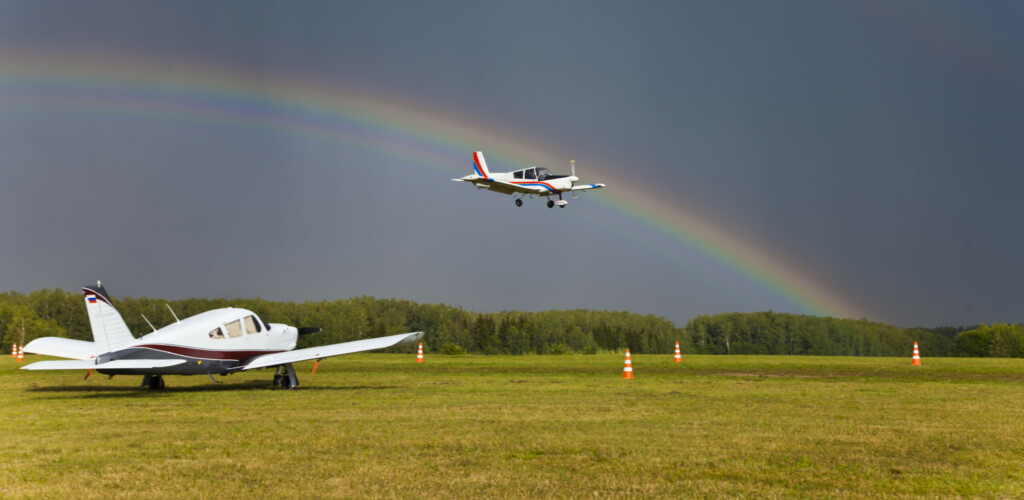
Credit to the reporter for sharing this experience which is a useful reminder that vigilance, patience and good post-flight habits are just as important on the ground as they are in the air.
Key Issues relating to this report
Human Factors Considerations
The following ‘Dirty Dozen’ and other Human Factors were central to CHIRP’s discussions about this report and are intended to provide food for thought when considering aspects that might be pertinent in similar circumstances.
Positive elements:
- Situational awareness – conducted a thorough walk-round that identified damage.
- Safety mindset – openly reflected and shared the experience for wider learning.
- Learning culture – recognised personal lapse and extracted key safety lessons.
Negative elements:
- Distraction – attention divided between finding a marshaller and observing another aircraft.
- Confirmation bias – interpreting the ‘bump’ as uneven grass rather than a collision.
- Complacency / task focus – narrowed attention during taxi, reducing overall spatial awareness.
